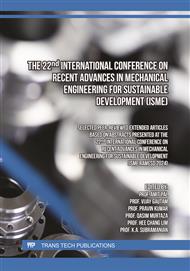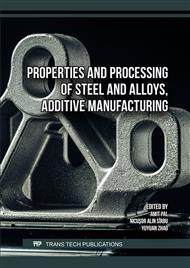[1]
D. Jang, J. Jung, J. Seok, Modeling and parameter optimization for cutting energy reduction in MQL milling process. Int J Precis Eng Manuf-Green Tech (2016) 3:5–12.
DOI: 10.1007/s40684-016-0001-y
Google Scholar
[2]
S. Debnath, M.M. Reddy, Q.S.Yi, Environmental friendly cutting fluids and cooling techniques in machining: a review. J Clean Prod (2014) 83:33–47.
DOI: 10.1016/j.jclepro.2014.07.071
Google Scholar
[3]
S.H. Musavi, B. Davoodi, M. Nankali, Creating the micro-grooves on tool rake face for improving the anti-wear properties. Modares Mech Eng (2018) 18:1–10.
Google Scholar
[4]
S.H. Musavi SH, B. Davoodi, S.A. Niknam, Environmental-friendly turning of A286 superalloy. J Manuf Process (2018) 32:734–743.
DOI: 10.1016/j.jmapro.2018.04.005
Google Scholar
[5]
R.M. Park, Risk assessment for metalworking fluids and cancer outcomes. Am J Ind Med (2018) 61(3):198–203.
Google Scholar
[6]
B. Davoodi, S.H. Musavi, M. Nankali, Development a new cutting tool by changing the surface texture for increasing the machining performance. Modares Mech Eng (2017) 17(7):441–450.
Google Scholar
[7]
K.K. Gajrani, D. Ram, M.R. Sankar, Biodegradation and hard machining performance comparison of eco-friendly cutting fluid and mineral oil using flood cooling and minimum quantity cutting fluid techniques. J Clean Prod (2017) 165:1420–1435.
DOI: 10.1016/j.jclepro.2017.07.217
Google Scholar
[8]
S. Ghosh, P.V. Rao, Application of sustainable techniques in metal cutting for enhanced machinability: a review. J Clean Prod (2015) 100:17– 34.
Google Scholar
[9]
S.H. Musavi & B. Davoodi, Risk assessment for hazardous lubricants in machining industry, Environmental Science and Pollution Research (2021) 28:625–634.
DOI: 10.1007/s11356-020-10472-1
Google Scholar
[10]
A.K. Cakir, A new approach to minimize carbon emission rate in turning processes, International Journal of Low-Carbon Technologies 2021; 16, 1444–1452, The Oxford University Press.
DOI: 10.1093/ijlct/ctab058
Google Scholar
[11]
K. Fang, N. Uhana, F. Zhao, J.W. Sutherland, A new approach to scheduling in manufacturing for power consumption and carbon footprint reduction. J Manuf Syst (2011) 30:234–40
DOI: 10.1016/j.jmsy.2011.08.004
Google Scholar
[12]
L.I. Tong, C.C. Chen, C.H. Wang, Optimization of multi-response processes using the VIKOR method. Int J Adv Manuf Technol (2007) 31:1049–57.
DOI: 10.1007/s00170-005-0284-6
Google Scholar
[13]
T. Gutowski, The efficiency and eco-efficiency of manufacturing. Int J Nanomanuf (2010) 6:38–45.
Google Scholar
[14]
J.S. Song, K.M. Lee, Development of a low-carbon product design system based on embedded GHG emissions. Resour Conserv Recycling (2010) 54: 547–56.
DOI: 10.1016/j.resconrec.2009.10.012
Google Scholar
[15]
Y. Halevi, E. Carpanzano, G. Montalbano, Y. Koren, Minimum energy control of redundant actuation machine tools. Manuf Technol (2011) 60:433–6.
DOI: 10.1016/j.cirp.2011.03.032
Google Scholar
[16]
T. Bhuiyan, I. Ahmed. Optimization of cutting parameters in turning process. SAE Int J Mater Manuf (2014) 7:233–9.
Google Scholar
[17]
M.T. Sijo, N. Biju, Taguchi method for optimization of cutting parameters in turning operations. AMAE Int J Manuf Mater Sci (2011) 1:44–6.
Google Scholar
[18]
S. Dharindom, S. Dhrupad, B.B. Parimal, N. Thuleswar, Taguchi optimization of cutting parameters in turning AISI 1020 MS with M2 HSS tool. IOP Conference Series: Material Science Engineering (2017) 225 012186.
DOI: 10.1088/1757-899x/225/1/012186
Google Scholar
[19]
J.R. Duflou, J.W. Sutherland, D. Dornfeld, C. Herrmann, J. Jeswiet, S. Kara, M. Hauschild and K. Kellens, Towards energy and resource efficient manufacturing: a processes and systems approach. Manuf Technol (2012) 61:587–609.
DOI: 10.1016/j.cirp.2012.05.002
Google Scholar
[20]
G.T. Gutowski, B.J. Dahmus, A. Thiriez, Electrical energy requirements for manufacturing processes. In 13th CIRP International Conference of Life Cycle Engineering. Leuven, Katholieke Universiteit Leuven, ISBN: 905682712X, 9789056827120 (2006).
Google Scholar
[21]
W. Li, S. Kara, An empirical model for predicting energy consumption of manufacturing processes: a case of turning process. J Eng Manuf (2011) 225:1636–46.
Google Scholar
[22]
Y.T. Iç, F.S. Akkoç, N. Gümü¸sboga, Z. Ballı, Development of a model that minimizes carbon emission in turning process. J Mach Des Manuf (2016) 14:1.
Google Scholar
[23]
C Li, Y. Tang, L. Cui et al. A quantitative approach to analyze carbon emissions of CNC-based machining systems. JIntellManuf (2015) 26:911–22.
DOI: 10.1007/s10845-013-0812-4
Google Scholar
[24]
A. Saravanakumar, P. Sreenivas, S. Vijayakumar, U. Pradeepkumar, L. Rajeshkumar, Optimization of drilling process parameters for self-lubricants reinforced aluminium metal matrix composites, Mat today: Proc (2022) 52(3):1461-1465.
DOI: 10.1016/j.matpr.2021.11.196
Google Scholar
[25]
R. Dhyani, A. Zindal, V.K. Singh and S. Chauhan, Tuning of MoS2 Particle in Al-Based Composite for Self-Lubrication, Solid-state Processing of Light Alloys (2023) 75:2949–2961.
DOI: 10.1007/s11837-023-05738-1
Google Scholar
[26]
S.R. Biswal and S. Sahoo, Self-lubricating Composite: A New Generation Metal Metrix Composite for Efficient Tribological Application, Proc. of ICPCM 2021 (2023).
DOI: 10.1007/978-981-99-5509-1_14
Google Scholar
[27]
M. Abbas, S. Kumar, A. Mittal, Optimization of cutting parameters to improve surface roughness of Al1070 in turning operation using Taguchi method, International Journal of Engineering Sciences & Research Technology (2016) pp.1324-1329.
Google Scholar
[28]
T.U. Siddiqui and R. Mittal, Mechanical and Tribological Characterization of Al1070 Alloy Based Self-Lubricating Metal Matrix Composites, Materials today: Proc (2023).
DOI: 10.1016/j.matpr.2023.04.667
Google Scholar
[29]
P.L. Menezes, P.K. Rohatgi and M.R. Lovel, Self-Lubricating Behavior of Graphite Reinforced Metal Matrix Composites, Chapter in Green Tribology (2012) 445–480.
DOI: 10.1007/978-3-642-23681-5_17
Google Scholar
[30]
A. Baradeswaran and A. Elaya Perumal, Influence of B4C on the tribological and mechanical properties of Al 7075–B4C composites, Comp: Part B (2013) 54: 146-152.
DOI: 10.1016/j.compositesb.2013.05.012
Google Scholar
[31]
A. Aatthisugan, R. Rose and D.S. Jebadurai, Mechanical and wear behaviour of AZ91D magnesium matrix hybrid composite reinforced with boron carbide and graphite, J. Magnes. Alloys (2017) 5: 20-25.
DOI: 10.1016/j.jma.2016.12.004
Google Scholar
[32]
P. Kumar P, B.P. Vijay Kumar, R. Joshi, T.H. Manjunatha, R. Sureshkumar, Valuation of Al7075 Reinforced with SiC for its Mechanical Properties & Surface Roughness by Drilling, Materials Today: Proceedings (2018) 5, 11(3): 25121-25129.
DOI: 10.1016/j.matpr.2018.10.313
Google Scholar
[33]
K.P. Furlan, J.D.B. De Mello, A.N.K. Klein, Self-lubricating composites containing MoS2: A review, Tribo Int (2018) 120: 280-298.
DOI: 10.1016/j.triboint.2017.12.033
Google Scholar
[34]
P. Kumar, SS Panda, Numerical simulation of Al1070 Alloy through hybrid SDP process, The International Journal of Advanced Manufacturing Technology, Vol 91, pp.835-846 (2016).
DOI: 10.1007/s00170-016-9768-9
Google Scholar
[35]
V.S. Srivastava, T.K. Gupta, A.K. Srivastava, S. Chauhan, P.K. Chauhan, Effects of cutting parameters on aluminium alloys-A review, Materials today: Proceedings, Vol 47(13), pp.3823-3827 (2021).
DOI: 10.1016/j.matpr.2021.03.091
Google Scholar
[36]
T. Gutowski, The carbon and energy intensity of manufacturing. 40th CIRP International Manufacturing Systems, Seminar. Liverpool University, UK (2007) 1–6.
Google Scholar
[37]
M.F. Rajemi, P.T. Mativenga, A. Aramcharoen, Sustainable machining: selection of optimum turning conditions based on minimum energy considerations. J Clean Prod (2010) 18:1059–65.
DOI: 10.1016/j.jclepro.2010.01.025
Google Scholar
[38]
S. Hu, F. Liu, Y. He and T. Hu, An on-line approach for energy efficiency monitoring of machine tools. J Clean Prod (2012) 27:133–40.
Google Scholar
[39]
www.energybangla.com
Google Scholar



